Dementia Of The Damned #4
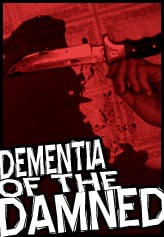
Summer is a time for lazy beach days and vacations, which is why this month’s Dementia of the Damned comes to you two weeks late. The drought of worthwhile horror has sent me deep into the Chambre de la Terreur to find the evil root of empty summer blockbusters that exercise the demons right out of the theaters. And I emerged with my arms full of old film reels of 1950s Sci-Fi Horror fit for DOTD.
The burning rays and stinking, smoldering humidity of Summer hardly induce fits of terror. Unless you count gouging your knee on that lone rock poking through your Crocodile Mile, there is very little to fear in the dog days of summer. Perhaps it’s the pool time games of Marco Polo that send the horror genre into remission – making way for C.G.-filled action spectacles of summer cineplexes. Yet, transforming robots and alien invaders alike all have their roots firmly planted in a horror sub-genre – Sci-Fi Horror.
While the likes of Sleepaway Camp and Friday the 13th keep horror purists satisfied, the summer drought gives horror hounds a break from the modern-day guts and gore and the chance to travel back to a time when giant monsters, aliens and even the subconscious dominated drive-in movie screens. It seems that nearly every film of the 1950s (at least the ones worth remembering) promised a glimpse at the most horrific spectacle imaginable. Unlike the empty spectacles of today’s invasion flicks, the Sci-Fi horror of the 1950s reverberated the terror of the very real possibility of nuclear holocaust and scientific experimentation. Just as the psycho killer plays on our irrational fears and senses, the 50’s sci-fi horror attacks our psyche and spirit with enough camp and cheese to spark the need for the drive-in and the need for vintage 3-D glasses.
Man Vs. Martian
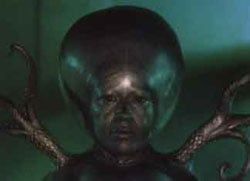
By 1953, the Cold War was at a fever pitch and McCarthyism was running rampant. It was a time of cultural fear and paranoia, which also saturated movie theater screens for the next decade. It was the one-two combination of the release of The War of the Worlds and Invaders from Mars in ’53 that kicked off the monster/alien craze. In both films, beings from outer space land in the heartland of America – usually a small town with good-natured folk, mischievous kids and apple pie cooling on the window sill.
Though the two films may have been released a mere four months apart, Invaders in April and War in August, they have very distinct agendas. Invaders from Mars tackles McCarthyism and the arms race through the eyes of a sympathetic young boy who sees a spacecraft land outside of his house. As the townsfolk become cold and unemotional, the “mysterious meteor” that fell behind the young boy’s house is found to be the cause. Between the “golly” and “gee-wiz,” the film clearly takes aim at the audience’s sympathy. With the young boy as the stand-in for the future of America, his visions of an invading threat controlling the great people of his town represent a fear that we are not likely to understand today. We are the apathetic townsfolk who act when it’s already too late. The face-painted men in the green jump suits, however, are always good for a giggle.
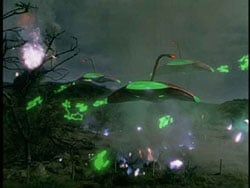
Never mind the story of antagonistic aliens destroying mankind, The War of the Worlds is as different a film from Invaders from Mars as one could be – at least in tone and substance. Cruddy remakes aside, the 1953 film focuses on the ebb and flow of faith. When a meteor lands near Dr. Clayton Forrester’s campsite, he heads to the nearby, small American town where town square dancing is a Friday night event to investigate. He becomes infatuated with a young woman, whose uncle is a Church Pastor. While the military is gathered around, determining the course of action against the alien ship that has emerged from the meteor, the Pastor goes out to meet the meteor under religions pretense. He presents the only humane approach, filled with kindness and understanding, and he’s promptly vaporized for his efforts.
CINEMABLEND NEWSLETTER
Your Daily Blend of Entertainment News
The loss of faith could be related to the feeling of impending doom. As the U.S. and Russia raced to amass the greatest stockpile of arms, the world community seemed to be its own ticking time bomb. After the Pastor is annihilated in the film, panic and destruction ensues; there is a lost of humanity as people pile into trucks heading out of town, kicking off the weak, dead weight of the elderly. Although the Martians die in the end, due to the combination of our viral contagions and their weak immune systems supposedly brought to justice by God, from loosing faith to being saved, the human chaos is very real.
Man Vs. Mutant

While the Cold War fueled the fear of nuclear destruction, scientific advancements fueled the Cold War. In each passing moment, scientists worked on new technologies of destruction. In developing hydrogen bombs in the mid ‘50s, the horror of nuclear mutation was a reality, especially with the post-World War II Hiroshima and Nagasaki. Despite the frightening truth, the nuclear horror manifested itself in Hollywood and beyond as larger-than-life monsters. Starting with Godzilla (1954) and Them (1954), aliens seemed to give way to mutant monsters – inadvertently created by nuclear testing.
Without the quick and glossy use of C.G. effects, these monster-horror pioneers resorted to practical effects, man in suit in the case of Godzilla and full size monster ants of Them that ravage a small American town (seeing a pattern?). Although there wasn’t a giant leap in special effects technology, there was an effects explosion in stop motion animation. Though the technique has been around since the early 1910s, it was put to full use in nearly every 1950s Sci-Fi film. From growing pod people to flying saucers and giant monstrosities, painstaking stop motion animation lit up the screens and shocked audiences with the latest terrifying creation.
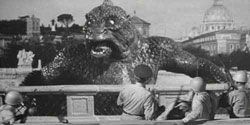
Among the mutants, Ray Harryhausen’s alien monster in 20 Million Miles to Earth is one of the most impressive displays of stop motion of the era. Released in 1957, the film revolves around a monster from outer space that threatened the city of Rome. Granted, there isn’t much thematic depth to 20 Million Miles to Earth, but in what other film can you see an alien monster fight an elephant in front of the Roman coliseum? While the film starts off with the suspense and mystery of the unknown creature growing exponentially, the film slips into a breath-taking spectacle.
Sometimes, the alien invaders aren’t the normal shades of green. The maroon blob creeps, crawls and grows to the size of buildings in the classic 1958 film. Again following that classic framework of an alien species invading a small American town sets up the premise for The Blob. Again, not much to say thematically, other than the outer-space creature mirrors our own endless consumerism as it literally consumes everything in its path. With the pop-of-the-day theme song, The Blob is a pulpy piece of 50s horror fit for a warm evening with a glass of lemonade.
Man Vs. Mind
The common cliché is that man is his own worst enemy – destroying both himself and his environment for an ideal, belief or product. It’s obsession that changes people, in which trusted friends and neighbors cease to be. And it’s exactly that cliché that inspired some of the 1950s most terrifying efforts. Dementia is one of the few genuinely creepy films from the decade.
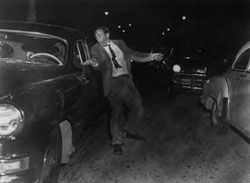
The film follows a young woman who is driven by her broken-home upbringing to give into fits of terrible violence. Originally filmed in 1955, Dementia was deemed so extreme by the censors that it was banned and never given distribution. From a fat bourgeois man buying a prostitute and ogling dancing girls to our anti-heroine chopping of that fat man’s hand, given the era, the film is uncompromising in its presentation. It recalls the work of David Lynch, as a surreal mood is created by the film’s soundtrack. It’s essential a silent film with a scored soundtrack. However, several sound effects, such as the crashing waves in a dream sequence to the lighting of a match, are emphasized. The lack of dialogue is hardly noticed, as the images are engaging as the film probes the disturbed girl’s mind.
As an interesting side note: Due to the ban in 1955, the film, a mere 56 minutes long, was cut by more than 20 minutes, given a horrible voice over and released under the title Daughter of Horror. Interestingly enough, the film was still mostly unseen until the title appeared on the marquee of the theater featured in 1958’s The Blob. Like Wes Craven putting a torn Jaws poster in the original The Hills Have Eyes and Sam Raimi putting a torn Hills poster in Evil Dead, the tradition of new directors paying their respects to the films of the past is alive and well back in the 50s.
Although not as cerebral, 1956’s Invasion of the Body Snatchers is a terrifying look at a disconnected culture and paranoia. An ambiguous look at Communism, McCarthyism or any other intellectual idea that infects society, Invasion of the Body Snatchers is told from the perspective of the lone survivor of a town taken over by pod people. An alien race secretly begins growing people in large pea pods. When a person goes to sleep, the switch is made and the pod person replica takes over.
Using shots in which the character talks directly to the audience, director Don Siegel creates an uneasy feeling that any one could be an unsuspecting pod person. As the film progresses, Siegel’s framing becomes more obtuse and filled with light and dark contrast. Unfortunately, the “happy” ending feels tacked on, but few films in the 50s were able to leave a story open-ended without any resolution. Still, with people replaced by pods in original Invasion (that’s right, the Invasion hitting theaters this summer is a remake) and mind-altering creepiness of Dementia gives substance to a sub-genre that is commonly thought of as mindless drive-in fodder. But we horror folk don’t have to be so serious all the time. Instead of spending all our time locked away in dark rooms, examining the latest horror offerings, wait for the sun to go down, hop in the car and enjoy the campy fun of summer. For the cold winds and chilling nights of autumn are just around the corner.
Most Popular







